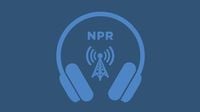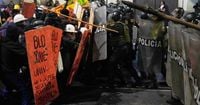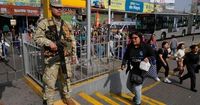Peru’s capital, Lima, has been thrust into the international spotlight after the government declared a 30-day state of emergency, a move that has rattled both citizens and investors. The declaration, made by interim President José Jerí on the evening of October 21, 2025, extends to the neighboring port city of Callao and comes against a backdrop of mounting unrest, surging crime, and political upheaval.
According to the Associated Press, the emergency measures were announced as authorities grappled with a wave of violent crime that has swept through Lima and Callao. In a bid to restore order, the government has granted itself exceptional powers, including the suspension of certain civil rights such as freedom of assembly. This controversial step, while ostensibly aimed at tackling crime, has fueled suspicions among many Peruvians and international observers that the true intent is to stifle weeks of anti-government protests that have rocked the capital since the impeachment of former President Dina Boluarte.
The unrest in Lima is not new. For over a month, youth-led demonstrations have taken to the streets, voicing deep dissatisfaction with the political establishment and the government’s perceived inability to address rising violence. The protests, which began as a response to unchecked crime, quickly evolved into broader calls for political reform and greater transparency. The movement gained further momentum after former President Boluarte was removed from office, a development that many protesters saw as both a symptom and a cause of Peru’s ongoing instability.
As reported by NPR and Al Jazeera, the government’s decision to declare a state of emergency is widely seen as a pivotal moment in the country’s crisis. While President Jerí has framed the measure as a necessary response to “spiraling crime,” critics argue that it is a thinly veiled attempt to suppress dissent. “Peru’s interim president has declared a state of emergency in Lima because of crime, but many believe it’s meant to curb weeks of anti-government protests,” NPR noted in its coverage.
The emergency declaration comes with a host of new rules and restrictions. Among the most notable is a ban on multiple people traveling on the same motorcycle—a measure aimed at curbing crimes committed by motorcycle-riding gangs, but one that has also drawn criticism for its impact on daily life. The government has also authorized the deployment of the army alongside police forces, a stark reminder of the seriousness with which authorities are treating the situation. According to Diario Correo, these extraordinary powers are designed to “maintain public order,” but they also raise questions about the balance between security and civil liberties.
The protests themselves have been marked by violence and tragedy. The Associated Press reported that clashes between demonstrators and riot police have left more than 100 people injured, including police officers and journalists. The unrest turned deadly last week when a man named Eduardo Ruiz was fatally shot during a demonstration. The Peruvian prosecutor’s office has launched an investigation into the police officer accused of firing the fatal shot, underscoring the high stakes and heightened tensions on the ground.
Calls for President Jerí’s resignation have grown louder in recent days, as protesters accuse his administration of failing to address the root causes of the crisis. Many see the state of emergency as an admission of failure, rather than a solution. “Protesters also called for Jerí’s resignation,” the Associated Press reported, highlighting the deep mistrust that has taken hold across much of the country.
The political turmoil has not gone unnoticed by the international community. Investors and foreign governments are watching closely, wary that prolonged instability could have far-reaching consequences for Peru’s economy. The agricultural and mining sectors—both critical to the nation’s economic health—are particularly vulnerable to disruptions caused by unrest and uncertainty. As Al Jazeera observed, “Social unrest often disrupts business operations, discouraging investment and reducing economic output.”
Jose Jerí, the interim president at the center of the storm, faces a daunting challenge. His leadership will be scrutinized not just by Peruvians, but by the world at large. Political analysts, as cited by Al Jazeera, suggest that Jerí’s ability to navigate the crisis and implement meaningful reforms could determine the pace at which Peru stabilizes and resumes normalcy. The government’s commitment to restoring order and addressing the demands of protesters will be crucial in restoring investor confidence and charting a path toward recovery.
Yet, the path forward remains anything but clear. The state of emergency, which suspends key civil rights and authorizes military involvement in domestic affairs, has created a complex and, some argue, precarious environment. While some citizens welcome the government’s tough stance on crime, others fear that the measures will only deepen divisions and prolong the crisis. The perception that the emergency is being used to silence dissent rather than address underlying issues has further eroded trust in the political process.
For many Peruvians, the current crisis is emblematic of broader challenges facing the country. Demands for political reform, greater transparency, and accountability have been at the heart of the protests. The events of the past weeks have laid bare the fragility of Peru’s democratic institutions and the urgent need for dialogue and reconciliation.
As the 30-day state of emergency unfolds, all eyes will be on Lima. The outcome of this critical period will likely shape Peru’s political and economic trajectory for years to come. Investors, citizens, and international observers alike are hoping for a resolution that restores stability without sacrificing the fundamental rights and freedoms that underpin any healthy democracy.
In the meantime, the people of Lima and Callao must navigate a new reality—one defined by curfews, military patrols, and a palpable sense of uncertainty. Whether the government’s extraordinary measures will succeed in quelling unrest and restoring order remains to be seen. What is clear, however, is that Peru stands at a crossroads, its future hanging in the balance as it confronts the twin challenges of crime and political upheaval.


